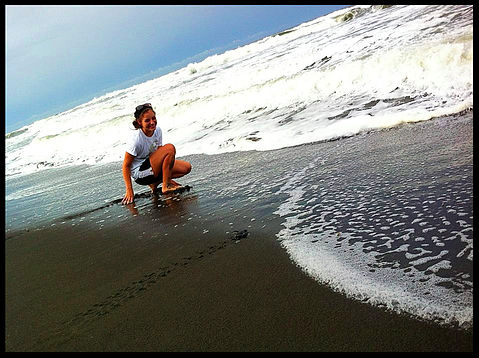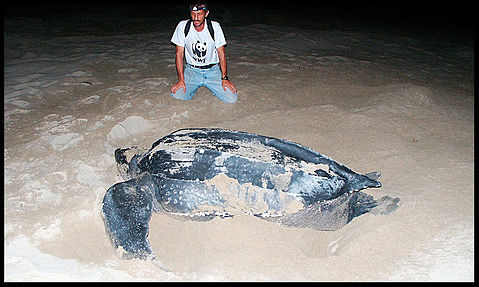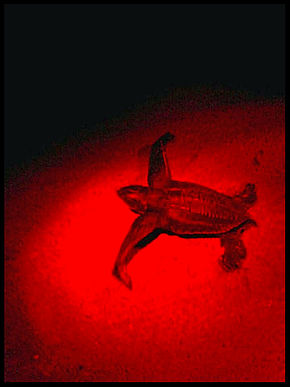My very first experience on a sea turtle conservation project was a midnight beach patrol on an incredibly remote islet on the Caribbean in Costa Rica. We were spending a week on a tiny stretch of beach with a scattering of rustic homes along the shore built by local fisherman. This beach was only accessible by a 45 min boat ride through crocodile-lurking canals, deep in a lush, vine-tangled jungle overhanging with noisy howler monkeys, sleepy sloths, and fast-moving Jesus Christ lizards.
Our arrival had been delayed due to a flat tire en route to the dock, and so we missed the official “Turtle Patrol Training” we were expecting to engage in before we began each of our shifts in search of the endangered, rare, and prehistoric Leatherback sea turtles who nested on these beaches during this season.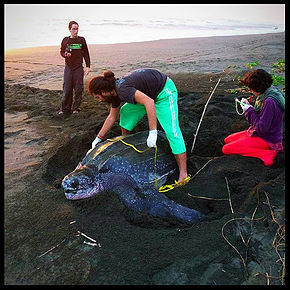
We ventured into the night, barefoot, clad in black, with dim, red-light flashlights in our hands following our local guide who spoke only Spanish. We trekked quietly in single file through the dark – myself, our Costa Rican guide, a dark-haired Canadian girl, and a dread-headed Swedish guy for our shift from 11pm to 3am seeking out nesting Leatherbacks.
The four of us had only met the night before, but here we were, trusting strangers, on the same mission to look for “tortugas”. We would relocate newly laid eggs, and deliver them safely to the hatchery where they would be monitored until they could hatch and climb back up through the sand, and make their way safely down the shore to the sea, protected from hunting crabs, digging dogs, poachers, seagulls, the sun, and so begin their 25 year voyage into adulthood.
This epic journey of the baby Leatherback from nest to sea would begin 45 days from tonight. However, and as we started off into the sand, and into the warm tropical night, we weren’t thinking about 25 years from now, or 45 days from now, we were thinking about this night, and if we would be lucky enough to even come across a Leatherback sea turtle.
I remember the beach was narrow, unpopulated and littered with driftwood. The jungle loomed high to our left, lush with palms, coconuts, and jungle insects. On our right, the unruly sea crashed loudly, and foamed rapidly all the way up to our feet with each smashing wave. And above our heads, a spray of stars… so many sparkling in the dark sky, that they almost touched. We walked north, in silence, harboured between the jungle and the sea, following our barefoot Costa Rican guide onward into the darkness.
We saw nothing for a long, long time. Then, without warning, our guide stopped. He didn’t turn around, but held up the back of his hand in a “stop” motion and whispered back toward us: “Tortuga”.
Ooooooh… Tortuga!!!! We were SO excited and so jittery! And quiet, of course, we couldn’t risk scaring the poor creature with our loudly hushed whispers – It was our first night on patrol, our first time in Costa Rica, and after 3 hours of walking in the silent darkness the moment was finally here . .HERE was a Tortuga!
We squatted down in the dark sand and waited while our guide snuck off to investigate.
It was so exciting.
I remember the waves, the jungle, the dark, the padding of our guide’s feet as he returned, and gestured for us to follow him.
I don’t know what I expected to see as we walked a little ways up the bank. A basket-sized turtle, perhaps, splashing around in the damp sand; a mess of a dug up hole …
As we crept up, I extended my arm and held out my red-light to see more clearly.
But my light did not reflect on the entire body of a turtle as I imagined. In fact, I wasn’t sure what I was looking at until I slowly waved my arm to the left, and then horizontally again to the right, very cautiously, taking it all in.
She was huge. Five feet in length, at least. And heaving. My light only extended over a portion of her shell at first glance. She was a beautiful beast. Her wide shell was as big as a dining table, her flippers, seemingly rowing waves into the black sand as she heavily dug her nest in the sand, her pre-historic face leathery, a little scale-y, with a wide mucus-y mouth.
I remember her eyes – dark and bright. Looking right back at me. I could hear her breathing. Working so hard to lay her 80 eggs or so, cover her nest and then return to the sea, hoisting her huge body over the sand towards the waves. Only then, did we turn and begin our conservation tasks with her nest.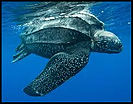
There are many reasons that people should travel, and should get involved in such projects: to see and to feel what the experience is really like. Living in another country isn’t always easy, and the hands-on projects are usually pretty challenging – but sometimes that’s what it takes to create such impactful memories. Such experiences. Such learning. A cultivation of education and culture immersion wrapped up into a three week experience overseas.
What was in that moment on the beach that night? Contact with an incredible species? Cultural interaction in its most unique moment? Discovery? Connection with others? Learning? Experience?
We can label these moments later, in reflections, when these are memories we are reliving. But in the moment, it’s truly only awe that we feel. Seeing a nesting sea turtle up close is AWEsome. Helping a species survive is incredible.
These are the experiences and feelings that strike a chord inside us. Makes us think. Makes us feel. Makes us understand what making an impact truly means.
It’s the reason we do what we do. 🙂
– Christy Nichols